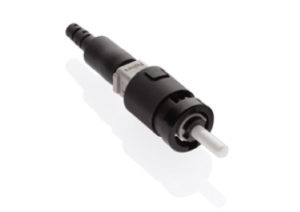Cleerline SSF LC Fiber Connectors (10-Pack or 25-pack)
– LC-MMFPC for Multimode OM2 / OM3 / OM4 Fiber (Aqua Blue)
– LC-SMUPC for most Singlemode OS2 Fiber Applications (Dark Blue)
– LC-SMAPC for Singlemode OS2 Fiber at Demarc from Service Provider (Green)
Cleerline SSF LC Fiber Connectors (10-Pack or 25-pack)
– LC-MMFPC for Multimode OM2 / OM3 / OM4 Fiber (Aqua Blue)
– LC-SMUPC for most Singlemode OS2 Fiber Applications (Dark Blue)
– LC-SMAPC for Singlemode OS2 Fiber at Demarc from Service Provider (Green)
Cleerline SSFSC Fiber Connectors (10-Pack & 25-pack)
– SC-MMFPC for Multimode OM2 / OM3 / OM4 Fiber (Aqua Blue)
– SC-SMUPC for most Singlemode OS2 Fiber Applications (Dark Blue)
– SC-SMAPC for Singlemode OS2 Fiber at Demarc from Service Provider (Green)
Cleerline SSF Universal 125um Mechanical Fiber Splice (10-pack)
Cleerline SSF Universal 125um Mechanical Fiber Splice (10-pack)
Cleerline SSF Universal 125um Mechanical Fiber Splice Tool
Click Here For Custom Fiber Termination Ordering Instructions
Showing all 9 results

There are many different types of fiber optic connector, so choosing the correct one can be confusing. Think of it this way: if terminating RG6 coax you could use a F, RCA, or BNC connector depending on your installation requirements. Similarly, choosing the right type of fiber optic connector depends on the equipment and type of optical fiber you are installing. Adapters are available, but it is always easiest to determine both fiber type and connector style ahead of time. In this article, we’ll discuss some common types of fiber optic connectors.
There are quite a few different styles of connectors. In the USA for networking and audio/video, the three most popular styles are LC, SC, and ST. LC and SC tend to be the most commonly used styles. Today, ST connectors are seeing more limited usage.
A Lucent connector (LC) is a connector with a 1.25 mm ferrule, half the size of SC or ST connector. LC connectors are frequently used as their small footprint makes them ideal for high-density installations. Similarly, these connectors are often required for SFP (small form-factorable pluggable) modules and fiber optic extenders, although this varies by manufacturer. LC connectors, again, are smaller in size and feature a clip design.
A 2.5 mm snap-in connector. This was the first connector chosen for the TIA-568 standard and is a snap-in connector that latches with a simple push-pull motion. SC connectors, as noted above, are larger than LC connectors. SC connectors are used with some styles of fiber optic extenders, although LC tends to be more common.

A ST connectors is a 2.5 mm AT&T™-designed connector. It has a bayonet mount and a long cylindrical ferrule to hold the fiber. Most ferrules are ceramic, but some are metal or plastic.
Connector style is determined by the equipment that the fiber cable will be plugged into, as well as the type of fiber you are using. If you know what equipment you will be using, you will be able to determine which style of connector to install. As noted above, LC connectors are a common choice for high-density installations and almost exclusive in network applications.
Fiber connectors are designed specifically for the type of fiber you are using.
Single mode uses a 9/125 connector, which refers to the core and cladding diameter of the optical fiber (i.e. core of 9 µm and cladding of 125 µm).
Multimode fibers require either a 50/125 µm (OM2/OM3/OM4) or 62.5/125 (OM1) connector. For more information on the difference between single mode and multimode fibers, visit our article.
Connectors are available with differently polished endfaces, which impacts the connector’s level of return loss (back reflection). Single mode connectors are available either as a UPC (Ultra Physical Contact) or APC (Angled Physical Contact/Angled Polish Connector).
UPC connectors are most commonly installed. These connectors have an endface which is slightly domed. For identification, UPC connectors are colored blue.
APC connectors feature an 8 degree angle at the endface. This decreases their return loss. However, APC connectors have very specific applications (GPON, FTTx, etc.) and used only when equipment requires. APC connectors are commonly used by service providers or for very long distance transmission. For identification, APC connectors are colored green.
Due to the angle of an APC connector, it cannot be mated to a UPC connector. These connector types are not interchangeable, so it is very important to verify whether your installation requires UPC or APC connectors.
Connectors are color-coded to identify multimode connectors and single mode APC or single mode UPC connectors.
Color coding can have some variation, so it is important to always double check the connector’s specifications.
If you have a SC-style connector installed and find that you need LC instead, you can purchase a SC-SC coupler, then purchase a pre-terminated SC to LC patch cable. This is a very common solution. Adapters are also available LC-LC or LC-SC.
Patch cables can be purchased with all various configurations (SC-SC, SC-LC, etc.). Again, the type of equipment you are installing will determine your connector needs. There are also various adapters and patch cable configurations that can be utilized to connect fiber optic-based equipment.
To choose the correct fiber connector, here are some points to consider:
Remember, always check the requirements of your installation before purchasing fiber optic connectors.
Please note: Custom cable orders have a lead time of 10 – 14 days. Custom Terminated Fiber is non-returnable and cannot be changed once production starts. Therefore, examine your order closely and ensure that the length and connectors are appropriate to your needs before placing your order.
WARNING: This product may expose you to chemicals including DINP and/or DEHP, which are known to the state of California to cause cancer and birth defects or other reproductive harm. For more information go to www.P65Warnings.ca.gov or our information page: California Proposition 65 Info.
